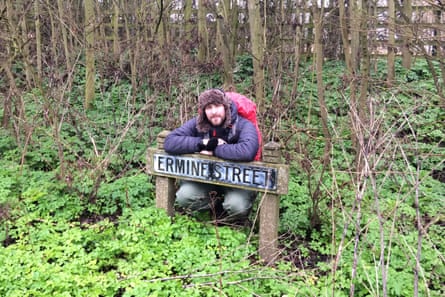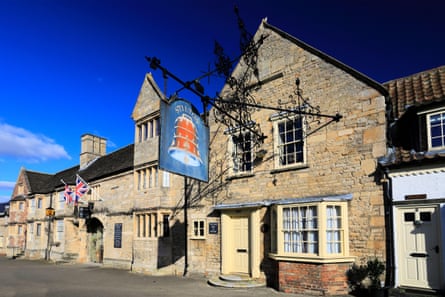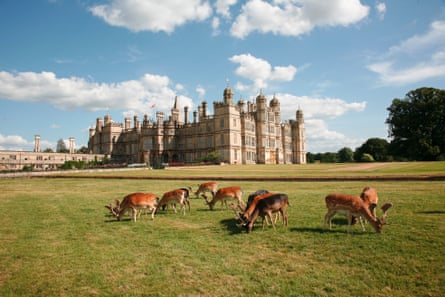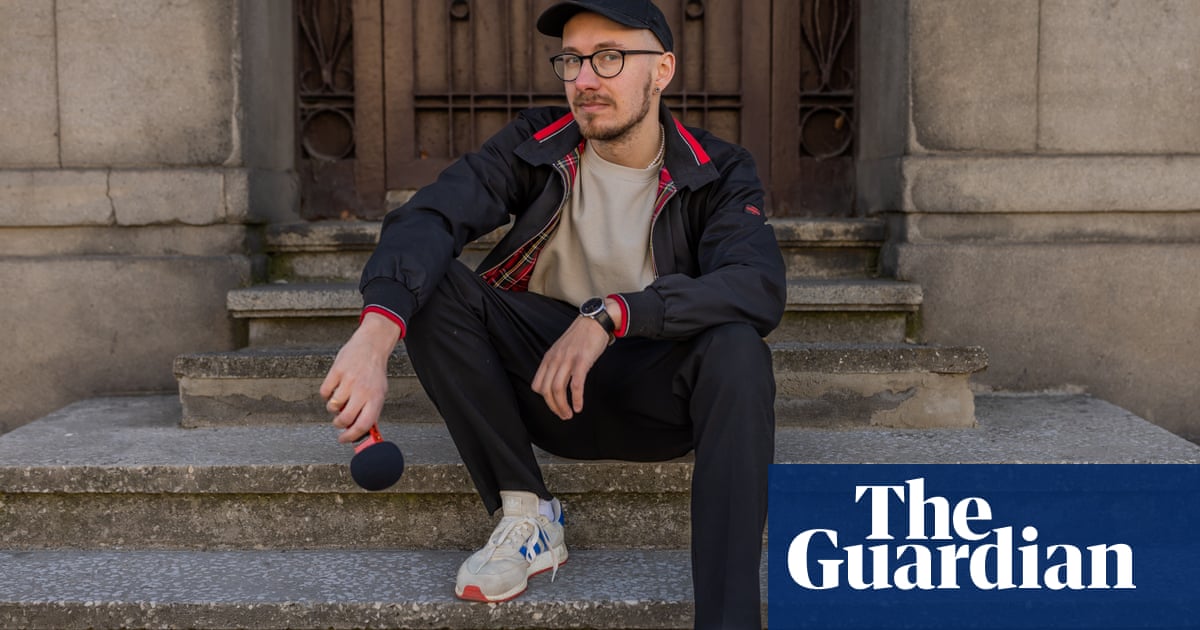After a while it is clear that someone, or something, is following us. A figure, some distance back. But here’s the thing: it doesn’t appear to draw any closer, or get further away. It seems to remain, matching our pace, just at the edge of vision – at the edge of the dusk now descending over the grand Lincolnshire parkland surrounding Burghley House. When we stop, the figure vanishes. When we set off again, it returns. A shrouded shape; a shadow stalking our steps.
Perhaps it shouldn’t be a surprise. The old Roman highway we’ve been intermittently tracing from Water Newton to Stamford is a nine-mile track layered with history. Now overgrown and concealed, it was once a bustling leg of a great north-south thoroughfare that has run, in some form or another, like a backbone through the body of Britain for at least 2,000 years. A unique assemblage of ancient trackway, Roman road, medieval path, pilgrim route, coach road and motorway. Today, hereabouts, its modern incarnation – the A1 – loops west, leaving, as it does in many places, forgotten, discontinued ghost highways to their own devices.
My fascination with the road connecting London and Edinburgh was sparked years ago. Joining an archaeological dig beside the A1 in North Yorkshire, I found myself unearthing the body of a man laid alongside an antecedent of the highway, perhaps 18 centuries earlier. Kneeling by that grave, a stretch of Roman road newly exposed to one side, the torrent-rush of the motorway to the other, the footings of future overbridges being hammered into the ground behind, I’d felt sharply aware of time – of past, present and future all meeting in that moment.

The feeling stayed with me. Obsessive investigations over the months that followed coincided with the discovery of photographs hinting at my family’s own connections to this highway, and I started to see it as far more than just a road. Rather, a timeline through this land; a repository of collective memory. I wondered what else was out there and began exploring its 400 miles whenever I could, walking and re-walking its howling carriageways and tangles of tributaries, up and down the country. Ten years of research culminated in my new book: The North Road. Blending non-fiction, memoir and short-story, it is part road movie, part novel; part history and part personal journey that braids a universal story of people and place through time.
So the leg to Stamford is a revisiting on my part. The idea of a friend and writer who lives nearby and wants to feel something of the aura of the road himself. We meet outside the Bell Inn in Stilton, on a museum-piece high street, bypassed now by the A1 and a world away from its previous life as a stop on the old highway. In the 1830s, 42 coaches and mails surged down Stilton’s high street every 24 hours. Their destinations persist, tattooed into the stone of the inn’s arch – as do the ubiquitous (and inevitably false) coaching inn rumours of Dick Turpin escapades. Inside, menus skew towards the Bell’s most renowned export: stilton. Made miles from here in Leicestershire, the cheese became a hit in the Bell’s dining room. Soon it was being sold from Stilton to every passing coach. The name stuck.

Lunchtime rarebits devoured, we drive up the A1 to Water Newton, six miles north. Its only thoroughfare (“Old North Road”) like a fibre worked loose from the thick rope of dual carriageway veering west to avoid the River Nene. Another preserved village emerges: drowsy stone houses, dewy lawns, willows. Rooks cawing. A snapshot England cut from a vintage motoring annual. It takes imagination to picture the huge Roman walled town and transport hub, Durobrivae, that once existed three fields to the east. The travellers, livestock, wagons, soldiers; the stink, smoke and fire; the warehouses, potteries, kilns and villas. And running through it, that wide Roman road north that came to be christened Ermine Street.
To join Ermine Street, we cross the glaze-green River Nene near the Norman church of St Remigius where a slab to a native son, Edward Edwards, reveals him to be the captain of HMS Pandora – the ill-fated frigate tasked with hunting down the mutineers from the Bounty in 1790. From here, the Hereward Way footpath tracking the Nene is the best route, joining up with Ermine Street further on, although highway purists like me may prefer to try a bit of rough walking along more of its laser-line straightness. For while reduced and buried, the Roman road still uncannily declares itself via a long ridge under earth, like an arm thrust under a duvet.
Fields, woods. Early skylarks over dwarf pasture. The entire afternoon is swallowed in open-stride walking, with the odd diversion down roads and tracks where necessary. Pausing for water, we find the base of a Saxon cross – Sutton Cross – in the undergrowth. Such relics of history are testament to the fact that there is no virgin earth anywhere in England. Later, approaching the parkland of Burghley House, the track becomes a footpath through green baize, spotted with stately oaks. We are tracing this along the vast estate wall, evening just beginning to fall, when we notice the figure following us.

Burghley was built by William Cecil, chief adviser to Elizabeth I, but the area is also profoundly connected to John Clare – the rural labourer and nature poet who was a gardener at the big house in his youth. In 1806, Clare jumped over this same estate wall on his way home from Stamford to read a book of poems. It was a Damascene moment that changed everything. Writing, fame and, eventually, fits of delusion, madness and internment followed, with Clare conducting his own last, epic foot journey up the north road in 1841, fleeing from an asylum and trying to get home. We are discussing this when the figure emerges.
I suggest we quicken our pace to reach the estate gate where the path joins the old Great North Road. When we do, we turn to find the figure has gone. But as we set off down the pavement, we both see it shuffling ahead of us, turning the corner towards Stamford, before disappearing into the dark.
Described by Sir Walter Scott as ‘‘the finest sight on the road between Edinburgh and London”, Stamford’s clusters of churches, mazy passageways and twisting thoroughfare give it the air of a condensed Oxford or Cambridge transposed to a leafy fold in Lincolnshire. The George, close to the point where the road bridges the River Welland, is its ancient coaching inn and is still doing great business. It’s less a place than a portal to be moved through – a feeling amplified as you pass under its 18th-century “gallows” sign, once doubling as welcome or warning to travellers.
Cromwell is rumoured to have overnighted. Charles I was also a guest, and his last evening of freedom was spent in the town. A century after, the “bloody” Duke of Cumberland, Butcher of Culloden, took dinner in the same panelled dining room we’re pulling up chairs in, after routing Charles I’s greatgrandson Bonnie Prince Charlie on a Scottish moor.
Over well-earned pints, we relive the dizzying depths of history experienced in a single afternoon’s walking along the highway. My friend brings up the figure again – the sheer strangeness of it. He shakes his head. But this is something you come to accept. Old roads lead to uncanny places. Time does stand still. The enormous past often possesses the present.
The North Road by Rob Cowen is published by Cornerstone (£22). To support the Guardian and Observer, order your copy at guardianbookshop.com. Delivery charges may apply

 2 months ago
107
2 months ago
107

















































